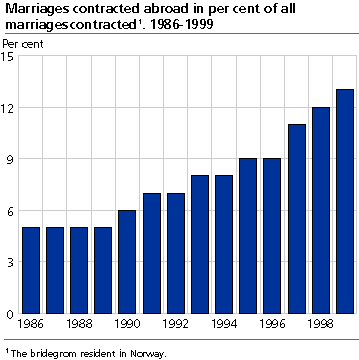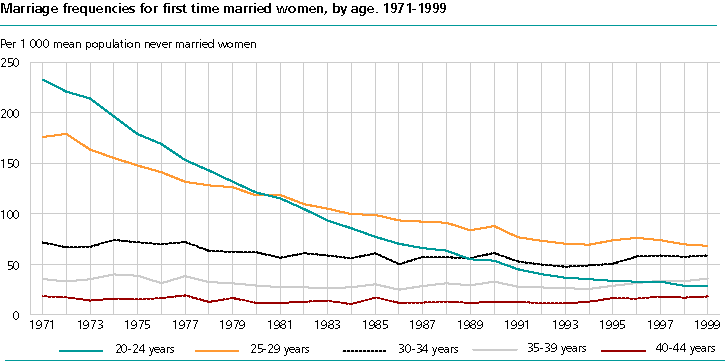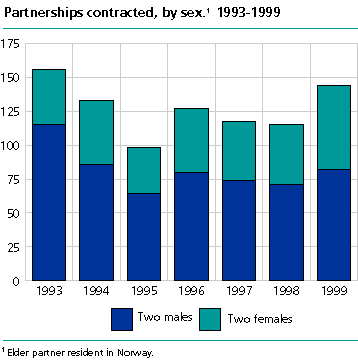Content
Published:
This is an archived release.
One in eight marries abroad
Nearly 3 000 couples got married abroad last year. This corresponds to one in eight couples, three times the rate of 15 years ago. Total marriages last year came to 23 500, the highest number in more than 20 years.
The number of marriages in 1999 increased by 1 100 compared to the previous year. Following a period of fluctuating marriage numbers from the mid-1980s, and less than 19 000 in 1992 and 1993, last years total was the highest since 1978. An increasingly higher share of the marriages took place abroad.
Marriage statistics vary depending on how the population is defined, whether it be the man, woman, both or only one of the parties who must be a resident of Norway in order for the marriage to be included in the count. The figure of 23 500 includes marriages in which the bridegroom was a resident of Norway at the time of the marriage. In 20 800 of these cases, both parties lived in Norway. The number of marriages increases to 24 900 when at least one of the parties is a resident of Norway at the time of marriage. The bride more often than the groom was living abroad at the time the marriage was contracted.
Ninth of the ninth ninety-nine?
In 1999 the number of marriages contracted in Germany peaked in September compared to previous years. The increase was attributed to that months rare number combinations. In Norway, the month of September was still far less popular than the summer months of June, July and August. The number combination 9.9.99 nevertheless proved irresistible to 100 couples a number many times higher than the two previous years who exchanged I-dos that day, despite the fact that the date fell on a regular weekday.
The last day of the millenium was a popular day to get married. In 1999 all of 35 per cent, i.e., 550 of all marriages in December, were performed on the 31st, against 20 per cent in the two previous years.
More tie the knot several times
An increasing number of people are marrying for the second or third time. While 4 700 bridegrooms got married for the second time, 500 men married for the third time. More men than women (4 100) married for the second time, a situation that has remained stable in the last few decades. The marriage rate of divorced men and women also indicates that it is becoming increasingly common to remarry. The rate increased again in 1999 and is the highest since 1990.
Increasingly older brides and bridegrooms
The average age for first marriages is approaching 30 for women, up from 28.9 years of age in 1999. For first-time bridegrooms the average age was as usual somewhat higher, 31.6 years. Among those who remarried in 1999, the average age was 46.0 for men and 42.2 for women.
Marriage trends must be viewed in context with cohabitation trends. In 1997, only one in 10 women born around 1970 chose to marry when living with a man for the first time. In 1999, cohabition was more common than marriage in the entire 16 to 29 age group. After that, from age 30 and up, married persons outnumber cohabitants, according to Statistics Norways omnibus surveys. As more and more couples live together first, thereby delaying marriage, the age at which people marry is also rising.
The marriage rate for men and women who married for the first time shows few changes for those under 30 years of age; if anything the rate dropped slightly. On the other hand the marriage rate is increasing for both sexes in the age group from 30 years up. In many cases it is those who have lived together for a while who are now getting married. In the individual five-year groups it was women aged 25-29 years and men aged 30-35 years who had the highest marriage rates in 1999.
If the marriage pattern for 1999 holds, as many as 40 per cent of all men and 35 per cent of all women will still be unmarried when they turn 50. In similar estimates made in the early 1990s, the percentage was higher for both sexes.
Slight increase in registered partnerships
In 1999 just over 140 registered partnerships were entered into, an increase of 30 over the previous year. With the exception of the first year, this many partnerships have not been registered in the course of a calendar year since the act on registered partnerships for homosexual couples became law on 1 August 1993. Ever since 1993, more men than women have entered into a same-sex partnership. At least three in five partnerships have been entered into by men, while in 1993 it was all of three out of four. In 1999, the numbers began to equalize, with female partnerships increasing to 43 per cent. Most registered partnerships were entered into by a one partner between the ages of 30 and 39 and a younger partner aged 18 to 29. Most live in Oslo.
Changes in statistics
Statistics on marriages and registered partnerships for 1999 have been changed on two points compared with the previous year: Firstly, all reports of marriages and partnerships are included in the statistics regardless of when the event took place (including before 1999). Secondly, the figures apply to marriages and partnerships in which the bridegroom or oldest partner is a resident of Norway, instead of cases in which at least one of the parties lives in Norway. Figures according to the old definition are available. See also About the statistics.
Tables:
- Table 1 Marriages contracted, by residence status of bride and bridegroom. 1950-1999
- Table 2 Marriages contracted, by type of marriage. 1961-1999
- Table 3 Marriages, 2,3, by previous marital status of the spouses. 1961-1999
- Table 4 Marriages. County. 1966-1999
- Table 5 Average age at marriage. Males and females. 1961-1999
- Table 6 Marriage rates for first time married males and females in selected age groups. 1961-1999
- Table 7 Marriage rates for divorced males and females in different age groups. 1950-1999
- Table 8 Marriage rates for widowers and widows in different age groups. 1950-1999
- Table 9 Marriages, by age of bride and bridegroom. 1999
- Table 10 Marriages, by marriage number of bridegroom/bride. 1966-1999
- Table 11 Marriages contracted, by month. 1976-1999
- Table 12 Marriages contracted 1999. Citizenship of female and male
- Table 13 Marriages contracted, by citizenship of male and female. 1999
- Table 14 Partnerships contracted. County. 1994-1999
- Table 15 Partnerships contracted, by age of the youngest and oldest partner. 1999
This page has been discontinued, see Marriages and divorces, Annually, detailed figures.
Contact
-
Anders Sønstebø
E-mail: anders.sonstebo@ssb.no
tel.: (+47) 46 66 37 74
-
Ane Margrete Tømmerås
E-mail: ane.tommeras@ssb.no
tel.: (+47) 91 99 29 62
-
Espen Andersen
E-mail: espen.andersen@ssb.no
tel.: (+47) 92 61 00 46
-
Statistics Norway's Information Centre
E-mail: informasjon@ssb.no
tel.: (+47) 21 09 46 42
-
Oppdrag befolkningsstatistikk
E-mail: befolkning@ssb.no



